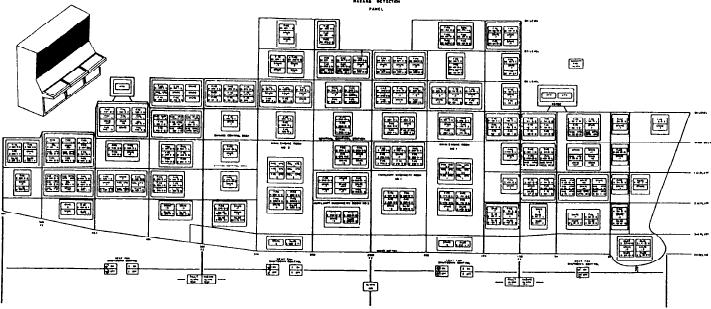
alarms. Depressing the FAULT ALARM TEST
DESIGN AND COMPONENTS
push button causes each fault alarm circuit in the
associated panel to start a fault alarm (l-Hz
The DCC is composed of three cabinet
flashing indicator and l-Hz tone). Releasing the
assemblies bolted together to form the console.
push button will end this test. Depressing the
(Refer to fig. 9-17.) These three sections, accessible
LAMP TEST push button illuminates all indicator
from the rear of the console, contain the card
lights that are not checked by one of the alarm
cages, power supplies, fuse and CB panel, and
tests.
interconnection panels. The front side of the
console houses the operator's panels, containing
all the meters, indicators, and switches necessary
Normal Securing
for normal operation. In the following paragraphs,
we will describe the design and components of the
The FSCC is secured by placing the main
DCC in reference to the front and back sections
power CB to the OFF position. The local panels
of the console.
are secured by placing the AC POWER switch to
the OFF position.
Operator's Panels (Front of Console)
The front of the console is composed of two
operator panels: the hazard detection panel (1A4)
DAMAGE CONTROL CONSOLE
and the firemain control panel (1A5). The upper
FOR DD-963/993 AND CG-47
CLASS SHIPS
panel is the hazard detection panel; the lower
panel is the firemain control panel. We will discuss
This section describes the major components
both panels in a left-to-right, top-to-bottom
and circuit functions of the damage control
fashion. The DCC operator panels on the CG-
class ship are basically similar. We will point out
console (DCC) located in the CCS, adjacent to
the FSCC. The DCC operates as an independent
any significant differences during the description
system from the FSCC and the ECSS. The only
of the panels.
interface between the DCC and the ECSS is
HAZARD DETECTION PANEL.--The
information received for GTM and GTG fire
conditions. The FSCC and the DCC are both
hazard detection panel has all the indicators for
manufactured by the same vendor. They have
the fire, smoke, temperature, and bilge hazard
many similar hardware items and circuit designs.
alarm circuits. (Refer to fig. 9-18.) Also provided
Figure 9-18.--DCC hazard detection panel (DD-963 class).
9-21

